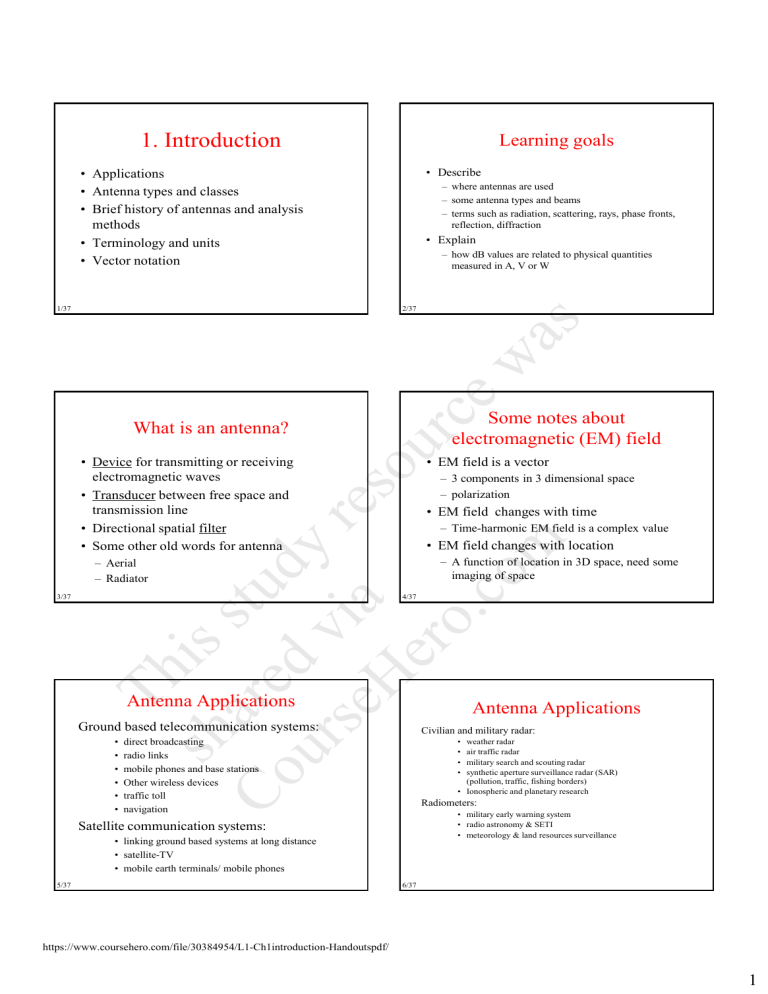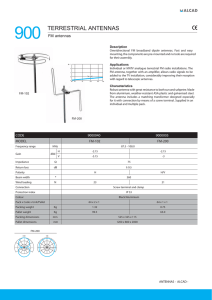pdfnhy
advertisement

1. Introduction Learning goals • Describe • Applications • Antenna types and classes • Brief history of antennas and analysis methods • Terminology and units • Vector notation • Explain – how dB values are related to physical quantities measured in A, V or W 2/37 Co are stud ur d v y se ia re so H er ur o. c ew co m as 1/37 – where antennas are used – some antenna types and beams – terms such as radiation, scattering, rays, phase fronts, reflection, diffraction Some notes about electromagnetic (EM) field What is an antenna? • Device for transmitting or receiving electromagnetic waves • Transducer between free space and transmission line • Directional spatial filter • Some other old words for antenna • EM field is a vector – 3 components in 3 dimensional space – polarization • EM field changes with time – Time-harmonic EM field is a complex value • EM field changes with location – A function of location in 3D space, need some imaging of space – Aerial – Radiator 4/37 Th is 3/37 Antenna Applications Antenna Applications Ground based telecommunication systems: Civilian and military radar: sh • • • • • • • • • • direct broadcasting radio links mobile phones and base stations Other wireless devices traffic toll navigation weather radar air traffic radar military search and scouting radar synthetic aperture surveillance radar (SAR) (pollution, traffic, fishing borders) • Ionospheric and planetary research Radiometers: • military early warning system • radio astronomy & SETI • meteorology & land resources surveillance Satellite communication systems: • linking ground based systems at long distance • satellite-TV • mobile earth terminals/ mobile phones 5/37 6/37 https://www.coursehero.com/file/30384954/L1-Ch1introduction-Handoutspdf/ 1 Antenna Technologies Antenna types The antenna is often the largest and most expensive part of a microwave system – – – – – – – – System technology Field theory Antenna theory and analysis methods Programming and CAD simulations Materials technology (also artificial materials, also called metamaterials) Manufacturing techniques Experimental development Measurements • • • • • • • • Traditional antennas were used for Line-Of-Sight (LOS) • Modern antennas are often used in multipath with Rayleigh fading, without LOS. • Since 2008: – New lecture about characterization of small antennas in multipath – Lecture about fundamental limitations of antennas 8/37 Co are stud ur d v y se ia re so H er ur o. c ew co m as 7/37 Wire Antennas Slot Antennas Microstrip Antennas Horn Antennas Reflector Antennas Dielectric Resonator Antennas Leaky Wave Antennas Different phased array antennas Examples of different antenna types 10/37 Th is 9/37 Today this is called a MIMO array Classes of Antenna Beams sh Array antenna types Linear and Planar Array Antennas: • Phase-steered Array Antennas • Active Arrays • MIMO arrays – Signal Processing Antennas – Digital Beam Forming – Adaptive Antennas 11/37 12/37 https://www.coursehero.com/file/30384954/L1-Ch1introduction-Handoutspdf/ 2 Quiz 1 Terminology and units • Radiation or scattering • Reflection, refraction, edge diffraction, aperture diffraction • Rays, waves, phase fronts, phase paths • Field and source units and dB What kind of beam does your mobile phone antenna have? 14/37 Co are stud ur d v y se ia re so H er ur o. c ew co m as 13/37 Reflection, refraction, edge diffraction, aperture diffraction Radiation / scattering 16/37 Th is 15/37 Rays, waves, phasefronts (or wavefronts), phase paths sh Units and dB 17/37 • • • • Electric field density E Volt/meter Magnetic current density M Volt/meter Magnetic field density H Ampere/meter Electric current density J Ampere/meter 18/37 https://www.coursehero.com/file/30384954/L1-Ch1introduction-Handoutspdf/ 3 Definition of dB dBi and dBm • In Antenna Engineering, we use dB • dBi means the reference is the isotropic antenna • dBm means the reference is 1 milliwatt. • dB/K means the reference is 1/K – dB is a relative measure, i.e., always compared to a reference value – dB is always a power ratio – dB value is always between 0 and ±200, easy to communicate A Aref dB = 20 log A Aref A = amplitude of E-field density P Pref dB = 10 log P Pref P = power density of wave 20/37 Co are stud ur d v y se ia re so H er ur o. c ew co m as 19/37 Amplitude and power ratios and their dB values Amplitude ratio 32 10 3.2 1 0.32 0.1 0.032 0.01 Power ratio 1000 100 10 1 0.1 0.01 0.001 0.000 1 Ratio in dB 30 dB 20 dB 10 dB 0 dB -10 dB -20 dB -30 dB Use dB, not % • Antenna efficiencies: Perce nt value 100% 99% 95% 90% 80% 64% 50% 25% 10% 5% dB value 0 dB -0.04 dB -0.22 dB -0.5 dB -1 dB -2 dB -3 dB -6 dB -10 dB -13 dB -40 dB • Good antenna engineers can control 0.1 dB • Measurement accuracy on gain, typ. 0.3 dB “Absolute” dB values Unit dBi reference isotropic dBm dBW dB/K 1 mW 1W 1/K 22/37 Th is 21/37 e dB = 10log e Explanation of symbols sh Quiz 2 ǀS11ǀ=0.1, S11= ̵ 20 dB or ̵ 10 dB? 23/37 24/37 https://www.coursehero.com/file/30384954/L1-Ch1introduction-Handoutspdf/ 4 The most used vector formulas: The most used vector formulas: • Vector cross product • Scalar (dot) product c=a×b C=A•B 26/37 Co are stud ur d v y se ia re so H er ur o. c ew co m as 25/37 The most used vector formulas: The most used vector formulas: • Removal of component of B in direction â to obtain C normal to â: C=B-(B•â) â • A dyad is a notation for a vector operation, e.g., D is a dyad if we write C B•D=B-(B•â) â B â (B•â) â 28/37 Th is 27/37 Brief History sh The most used vector formulas: • Scalar (dot) product C=A•B • Vector (cross) product C=AxB • Removal of component of B in direction â to obtain C normal to â: C=B-(B•â) â • A dyad is a notation for a vector operation, e.g., D is a dyad if we write C=B•D=B-(B•â) â 29/37 • • • • Maxwell’s equations 1864 Hertz 1888: parabolic metal cylinder Marconi 1901: Transatlantic transmission World War II: Radiating apertures, reflectors, Arrays 30/37 https://www.coursehero.com/file/30384954/L1-Ch1introduction-Handoutspdf/ 5 Brief History • Maxwell’s equations 1864 – One of the most beautiful equations • The first parabolic antenna, built by Heinrich Hertz in 1888 32/37 Co are stud ur d v y se ia re so H er ur o. c ew co m as 31/37 Brief History Brief History Brief History: Ray methods • Marconi 1901: Transatlantic transmission • • • • • • Euclid 300 BC: reflection law Alhazan 1000: lens Snell 1621: refraction Fermat, Hamilton 16-18 century: classical geometrical optics Sommerfeld 1884: edge diffraction Luneberg 1944, Kline 1951: modern geometrical optics (GO) Kouyoumjian, Pathak 1974-81: uniform geometrical theory of diffraction (UTD) • Several more authors 1960-today: asymptotic techniques Marconi watching associates raising the kite used to lift the antenna at St. John's, Newfoundland, December 1901 34/37 Th is 33/37 – In this course: a bit GO Brief History, numerical methods • • • • sh Brief History, wave theories • Galerkin, 1871-1945: Galerkin’s method • Harrington, 1968: Moment Method (MM) Huygen’s 1690: Huygen’s principle Fresnel 1830 Maxwell 1864: Maxwell’s equations Schelkunoff 1936: Equivalence principle – Also known as Boundary Element Methods • Finite Element Methods (FEM) • Finite Difference Time Domain Method(FDTD) • Spectral domain techniques – (spectrum of plane wave solutions) – (spectrum of 2D field solutions) – In this course: A lot of equivalence • In this course: Simple MM for deriving integral solutions 35/37 36/37 https://www.coursehero.com/file/30384954/L1-Ch1introduction-Handoutspdf/ 6 Learning goals • After this lecture and additional reading you should be able to summarily describe – where antennas are used – some antenna types and beams – terms such as radiation, scattering, rays, phase fronts, reflection, diffraction • and explain (repetition) – how dB values are related to physical quantities measured in A, V or W sh Th is Co are stud ur d v y se ia re so H er ur o. c ew co m as 37/37 https://www.coursehero.com/file/30384954/L1-Ch1introduction-Handoutspdf/ 7 Powered by TCPDF (www.tcpdf.org)


![EEE 443 Antennas for Wireless Communications (3) [S]](http://s3.studylib.net/store/data/008888255_1-6e942a081653d05c33fa53deefb4441a-300x300.png)